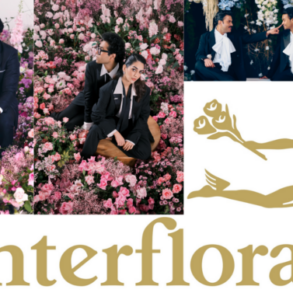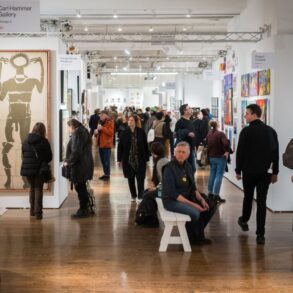Art Market
Arun Kakar
Nov 1, 2024 4:18PM
Interior view of Art Collaboration Kyoto, 2024. Photo by Moriya Yuki. Courtesy of ACK.
It’s not uncommon for two galleries to share a booth at an art fair these days, but nowhere has this practice been more evident than at Art Collaboration Kyoto (ACK), which opened its 2024 edition in the former Japanese capital on October 31st.
Rather than shunting these dual presentations to the side, the fair dedicates its main section to cooperative booths. Titled Gallery Collaborations, this area sees some 27 Japan-based galleries who invited 29 international peers to co-present what the fair bills as “unique and thoughtful exhibition[s]” in shared booths.
In a crowded art fair calendar where special sections and dedicated focuses abound, this could seem like a marketing gimmick to the cynical fairgoer. But, now in its fourth year, ACK has pulled off an event that feels fresh, illuminating, and quite unlike any other art fair running today.
A unique art fair in an idyllic setting
Maria Nepomuceno, installation view in Public Program at Art Collaboration Kyoto, 2024. Photo by Moriya Yuki. Courtesy of ACK.
Advertisement
Tucked away in the verdant hills atop Takaragaike Park in the north of Kyoto, ACK is a serene departure from the city’s commotion below. In the International Convention Center, the fair also has an ideal venue—a thoughtfully designed concrete complex that offers ample views of nearby scenery—to go with its location.
The fair’s VIP day on October 31st was as relaxed as its surroundings. Many fairs are spoken of as intimate occasions, but this is especially true of ACK. This year’s redesigned edition features double-sided wooden booths laid out in a grid-like structure where galleries are given the freedom to adjust the architecture of their displays.
Installation view of CON_ and WWNN’s booth at Art Collaboration Kyoto, 2024. Courtesy of the artists and CON_ and WWNN.
Unlike the more rigid aisles and closed booths of most art fairs, this setup allows visitors to ACK to wander between and around the booths in a less uniform fashion, encountering unexpected artworks along the way. During the VIP day, artists, visitors, and gallerists gathered in pockets around presentations: Exhibitors’ desks are placed outside instead of inside the booths, integrating the galleries’ representatives with the traffic of the fair. The result is a convivial mood in a considered arrangement that felt neither crowded nor quiet in the VIP day’s opening hours. Many of the galleries that are returning to the fair this year noted that its layout fosters a flexible and pleasant vibe throughout.
“We had experienced a great time meeting local galleries not only from Japan but also outside Japan,” said Eri Miura of Tokyo gallery CON_, which is sharing a booth with Seoul gallery Wwnn. “This art fair is very intimate, and there is more of a focus on the curatorial [aspect] of the presentations. It’s why we’re very eager to participate [again] this year.” The gallery’s curated display takes the form of what Miura called a “garden concept,” foregrounded by a large, slightly threatening ceramic flower by Apollinaria Broche.
Collaborative at its core
Interior view of Art Collaboration Kyoto, 2024. Photo by Moriya Yuki. Courtesy of ACK.
Distinctions between collaborators are blurred across the fair. The gallerists share their desks, and many chose not to distinguish the works on view with gallery-specific tags. For the invited galleries—many of which have little visibility in the Japanese market—this cohesiveness is a boon.
“For us to come to Japan to do an art fair [on our own] would be impractical in so many ways,” said Börkur Arnarson, co-founder of Reykjavík’s i8 Gallery, which was invited by Tokyo’s Misako & Rosen for a shared solo booth of delicately geometric paintings by Japanese artist Yui Yaegashi. “It’s super nice to be able to collaborate with a single artist in a friendly, noncompetitive way—two galleries that share the same aesthetics and interests.”
This sentiment isn’t just limited to smaller galleries, either. International gallery Mendes Wood DM is participating in the fair for the second time in a presentation with Tokyo gallery KAYOKOYUKI featuring works by artists including Solange Pessoa, Yohei Imamura, Yutaka Nozawa, Emi Otaguro, and Artsy Vanguard alum Paula Siebra.
Installation view of Shibunkaku and Kurimanzutto’s booth at Art Collaboration Kyoto, 2024. Photo by Moriya Yuki. Courtesy of ACK.
“Japan is not the kind of place where you can kind of drop in and meet everyone—you have to put in the time,” said Mendes Wood partner Martin Aguilera. “We’ve been coming to Japan for the last two years, really getting to know everyone, and it has culminated in great sales but also great institutional contacts.”
Like i8 and several other guest galleries at the fair, Mendes Wood works with one of the same artists (Kenji Ide) as the gallery that invited them. But other joint exhibitors came to collaborate through other ways, including friendships and shared interests. This was the case when Tokyo and Kyoto gallery Shibunkaku invited Mexico City powerhouse kurimanzutto.
“We met last year in Hong Kong, talked about art a lot, and found a lot of common things and shared common values,” said Natalie Ku, an assistant at Shibunkaku. “From the combination of their works and our works, they actually go very well together, even though our artists are from Japan and theirs are Mexican.” Their booth is one of the broadest in the fair, featuring works by seven artists from kurimanzutto, including Gabriel Orozco and Lilia Carrillo, along with works by 10 artists from Shibunkaku including Hakuin Ekaku and Yuichi Inoue. What sounds like it could be a hodgepodge of artworks turns out to be one of the fair’s standout booths, where unexpected connections can be found between the two programs.
Japanese art in the spotlight
While the fair hosts galleries from 18 countries and regions, Japanese artists are, unsurprisingly, common throughout. This is most prominent in the fair’s second section—Kyoto Meetings—which takes place next to the collaborative section and features 13 single-gallery booths showing “presentations with distinct connections to Kyoto.”
These included galleries such as Tokyo tastemaker A Lighthouse Called Kanata. For its debut presentation at ACK, the gallery is presenting works by six Kyoto-based artists including Sueharu Fukami, Niyoko Ikuta, and Eiko Kishi, who each showcase sculptural works that swirl, anchor, and slice their respective parts of the booth. This interaction is also a style of collaboration fostered by the Kyoto fair, explained founder Wahei Aoyama. “We thought that collaboration between Kyoto artists was more interesting for us this year.”
Japanese art is on view across both fair sections, however. Case in point: the booth of Los Angeles gallery Nonaka Hill, which specializes in Japanese art and earlier this week became a local gallery when it opened a new branch in Kyoto. “We fell in love with the city and the vibe, and felt like Kyoto was a place where we could collaborate with galleries in Tokyo from a distance and not be in their backyard,” said co-founder Rodney Nonaka-Hill. The gallery collaborated with Paris’s Crèvecœur and is hosted by Tokyo’s Mujin-To Production. The booth features works by artists such as the late sculptor Kenzi Shiokava and surrealist Tatsuo Ikeda, who are connected aesthetically by the visceral qualities of their sculptural works.
Kyoto’s growing cultural clout
Installation view of Taro Nasu and Matthew Marks Gallery’s booth at Art Collaboration Kyoto, 2024. Photo by Moriya Yuki. Courtesy of ACK.
If the fair itself wasn’t enough, ACK has additional visitor appeal since it falls in Kyoto’s famously beautiful autumnal season. Already one of Japan’s most popular tourist destinations, the city has a continually rising profile, with spending by inbound tourists increasing by 24.3% in 2023 compared to the pre-lockdown year of 2019, according to Japan’s tourism board. ACK, therefore, is perfectly placed to attract a broader swathe of international visitors, explained its director Yukako Yamashita.
“For us, every year we are receiving lots of local collectors coming from Japan or Kyoto,” she told Artsy. “At the same time, to build up our ecosystem, it’s essential to involve international collectors.”
Part of this approach can be seen in the fair’s expanded citywide programming, where several of Kyoto’s historical venues—which have few aesthetic parallels even in Japan—are being taken over with contemporary art and special events. For instance, Mendes Wood DM is staging gallery artist Lucas Arruda’s first Japanese solo show in Kyoto, not at a gallery but an ancient temple, Daitoku-ji Ōbai-in. Other renowned contemporary artists, including Bosco Sodi and Andreas Eriksson, are also the subjects of special exhibitions at venues across the city.
Bosco Sodi and Izumi Kato, installation view of “黙: SPEAKING IN SILENCE” at Ryosokuin Zen Temple, Kyoto, 2024. ©︎2024 Bosco Sodi. ©2024 Izumi Kato. Photo by Mitsuru Wakabayashi. Courtesy of Executive Committee, “黙: Speaking in Silence” exhibition.
The city’s astounding historical monuments create an opportunity for Kyoto’s contemporary art world, explained Hayashi Tasuta, director at Japan’s Agency for Cultural Affairs, which supports ACK. “These historic places are very unique to Japan. How can we introduce other elements of Japanese culture through contemporary art?” he told Artsy. He added: “I hope that through contemporary art we can also link this to [Japanese historical] culture and international guests can enjoy these things as well.”
Thus ACK finds itself a growing fair in a flowering local scene. Its first edition in 2021, which was twice postponed due to COVID-19, featured just over 50 galleries. This year’s total of 69 exhibitors is its largest yet, and Yamashita reported a 33% increase in applications for this year’s edition compared to 2023. Still, she cautioned, the fair’s growth must prioritize “quality over quantity.”
Bosco Sodi and Izumi Kato, installation view of “黙: SPEAKING IN SILENCE” at Ryosokuin Zen Temple, Kyoto, 2024. ©︎2024 Bosco Sodi. ©2024 Izumi Kato. Photo by Mitsuru Wakabayashi. Courtesy of Executive Committee, “黙: Speaking in Silence” exhibition.
“We try to commit ourselves to the future [but]to make it happen, we need sustainability,” she told Artsy. We’re not hesitant to grow. But the appropriate speed is really essential for us….Quality is everything for us.”
This is music to the ears of the regular fairgoer. No one needs another reason to visit Kyoto at this time of year, but ACK is giving international collectors one anyway. And the fair is ambitious about its aims: “It’s just the beginning for us and we are so happy,” noted Yamashita. “We really feel that we can make a bigger impact.” In an art world where collectors have the option to travel to ever more international art fairs, ACK is positioning itself as one of the most promising young fairs to watch.
Arun Kakar
Arun Kakar is Artsy’s Art Market Editor.



